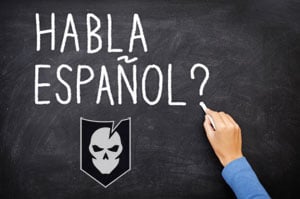A Guide to Practical Spanish Language as a Skill-Set – Lesson 1: The Holy Grail
A Guide to Practical Spanish Language as a Skill-Set – Lesson 1: The Holy Grail
 The ability to speak a second language is becoming an increasingly important skill-set. There are many ways to learn a language, from the not-so-good (software-based), to the best (immersion). This article should be used as a starting point to develop your skills in the Spanish language, but should not be your only resource. Interaction with native speakers, television, movies, radio shows and constant practice, should all be part of the learning process.
The ability to speak a second language is becoming an increasingly important skill-set. There are many ways to learn a language, from the not-so-good (software-based), to the best (immersion). This article should be used as a starting point to develop your skills in the Spanish language, but should not be your only resource. Interaction with native speakers, television, movies, radio shows and constant practice, should all be part of the learning process.
I don’t have a degree in Spanish or teaching, but I served as a Spanish Instructor at the U.S. Border Patrol Academy for four years and I’ll share with you the methods I learned and practiced at the time. My job as an Instructor was to prepare agents so they could conduct field interviews and interrogations in Spanish. Based on my experience over the past sixteen years, I believe adults are just as capable of leaning a new language as kids, but unlike adults, kids don’t worry about making mistakes or the perception of ridicule.
In this first lesson, which I call The Holy Grail, we’ll focus on pronunciation, which relies heavily on proper pronunciation of the vowels in Spanish. I’ve met people with many years of Spanish education who still can’t nail down the vowels. Practice the sounds and you’ll be able to properly pronounce any Spanish word.
I. Vowels and Special Characters
Good news: Unlike English, the sound of the vowels in Spanish never changes; ever. It doesn’t matter where they fall in a word.
- A (ah) like the a in “car”
- E (eh) like the e in “net”
- I (ee) like the i in “vaccine”
- O (oh) like the o in “order”
- U (oo) like the oo in “soon”
The Y (yeh), while not technically a vowel, can be used as a vowel, and sounds like the Spanish I. When used as a consonant it sounds like the y in “yes”.
Special Characters
The Spanish alphabet includes the Ñ, which sounds like the ny in “canyon”. The letters C and H are used together in Spanish much like the Ch in “chug”.
There are also two letters in Spanish that double up to give them a different sound:
- The first is L, which when doubled up (LL) sounds just like the Spanish Y when used as a consonant. It also sounds harder when spoken by people from southern Spain or the Caribbean.
- Examples: llave = key and llorar = to cry
- The second is R, which when doubled up (RR) sounds like a harder R. The R in Spanish is trilled, and the RR even more so. Practice rolling the R and you’ll be fine.
- Examples: pero = but and perro = dog (male)
- The H is always silent.
II. Diphthongs
Diphthongs are a combination of vowels in one syllable. The strong vowels are A, E, and O, while I and U are weak vowels. Diphthongs are formed by a strong vowel followed by a weak vowel, a weak vowel followed by a strong vowel, or two weak vowels.
- AI or AY (like the y in “bye”)
- Examples: aire = air and hay = there is / there are
- EI or EY (like the ey in “they”)
- Examples: rey = king and veinte = twenty
- OI or OY (like oy in “boy”)
- Examples: voy = I am going and oigo = I hear
- AU (like ow in “cow”)
- Examples: autor = author and causa = cause
- EU
- Examples: Europa = Europe and europeo = european
- UA
- Examples: cuatro = four and cuarto = room / fourth
- UE
- Examples: puerto = port and puesto = post (assignment)
- UO
- Example: cuota = quota or share
- IA
- Examples: diamante = diamond and hacia = toward
- IE
- Examples: piernas = legs and viejo = old
- IO
- Examples: palacio = palace and precio = price
- IU
- Examples: ciudadano = citizen and triunfo = triumph
- UI
- Examples: ruido = noise and cuidado = care
Exceptions
- UE and UI following a Q or G are not diphthongs, and the U is silent, unless it is a Ü.
- When the weak vowel has a written accent, it becomes a strong vowel, thus breaking the diphthong and forming two syllables.
III. Syllabication
The principles of dividing words into syllables are:
- A consonant goes with the following vowel.
- Examples: Pis-to-la = pistol and Brú-ju-la = compass
- Two strong vowels are separated.
- Examples: Ca-er = to fall and Le-er = to read
- Two consonants between vowels are usually separated
- Examples: Mar-ti-llo and Tor-ti-lla
- Diphthongs and triphthongs are not separated.
- Examples: Puer-to and Jui-cio
- A prefix forms a separate syllable.
- Examples: Ex-tra-er and Con-se-guir
Exceptions
- A consonant followed by R or L is not separated from the R or L, unless it’s RL, SL, TL, SR or NR.
- The letters LL, CH or RR are considered as one letter in Spanish and thus are not separated.
IV. Accentuation
Words ending in a vowel or “N” or “S” receive the stress of the voice regularly on the next to last syllable.
Examples:
- a-mi-go = friend
- fe-cha = date (calendar)
- ri-fle = rifle
- pis-to-la = pistol
Words ending in a consonant other than “N” or “S” receive the stress of the voice regularly on the last syllable.
Examples:
- mo-rir = to die
- bus-car = to look for
- mu-jer = woman
- ob-ser-var = to observe
Words stressed contrary to the aforementioned rules bear the written accent over the vowel of the syllable to be stressed.
Examples:
- ac-ción = action
- for-ma-ción = formation
- fá-cil = easy
- di-fí-cil = difficult
Certain words bear the written accent to distinguish them from other words spelled similarly and pronounced similarly, but having an entirely different meaning.
Examples:
- él = him el = the
- sí = yes si = if
- tú = you tu = your
- dé = give de = of, from
- mí = me mi = mine
The written accent is used to distinguish the exclamatory or interrogatory from the relative use of pronouns and adverbs.
Examples:
- ¿Cuándo vuelve Bryan? = When will Bryan return?
- Cuando Bryan vuelva tomaremos cerveza. = When Bryan returns we will drink beer.
The written accent over a weak vowel breaks up a strong/weak or weak/strong diphthong and results in two separate syllables.
- Example: pa-ís = country
V. Punctuation
Punctuation is the same in both English and Spanish with the following exceptions:
- An inverted question mark ( ¿) at the beginning of a question as well as the regular question mark (?) at the end.
- On a keyboard this is ALT + 168 or shift + option + ? on a mac
- An inverted exclamation mark ( ¡) at the beginning of the interjection as well as the regular exclamation mark (!) at the end.
- On a keyboard this is ALT + 173 or option/alt + ! on a mac
- The days of the week and the months of the year are not capitalized.
- The pronoun “yo” (I) is not capitalized, except at the beginning of a sentence.
- An adjective of nationality is not capitalized.
- Examples: Yo hablo español = I speak Spanish / Hablo con un mexicano = I am speaking to a Mexican.
The following abbreviations are capitalized.
- Ud. (usted) = you (formal)
- Uds. (ustedes) = you (plural)
- Sr. (señor) = Sir
- Sra. (señora) = Madam
- Srta. (señorita) = Miss
The next article will focus on parts of speech, adjectives, conjunctions and interjections, before moving to the Spanish sentence. Now go watch some Mexican soap operas (the visuals help), question your Spanish-speaking friends and start practicing. The best way to learn a new language is to dive into it until it becomes an effective tool in your tool bag.
¡Hasta luego!
Editor-in-Chief’s Note: You can also check out the Border Book in the ITS Store, if you’re interested in a field guide that focuses on the Spanish you’ll need to know to protect yourself and teaches English speakers to clearly communicate with uneducated or educated Spanish speakers.











Discussion